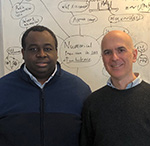Four codes that can change the future of energy use and cancer treatments
Plasma-PEPSC: A new centre of excellence for plasma simulations

Over the next four years, researchers at KTH will optimize four codes that can have significant impact on global energy use and the treatment of cancer patients. But competition is fierce between researchers in Europe, Japan, China and the US.
”We are looking into the future towards a new paradigm in large-scale plasma simulations”, says Stefano Markidis, Assosiate Professor of high-performance computing, when describing the EuroHPC Center of Excellence, a new four-year, European collaboration project led by KTH.
With the help of Europe's most powerful supercomputers LUMI and LEONARDO and MareNostrum 5, Markidis and his colleagues will look to improve four codes that can significantly improve plasma simulations applied to solve grand plasma challenges. And an important aspect of the research is that Europe wants to become more independent.
”It is about developing plasma simulations for fusion energy, plasma accelerators and space physics on extreme-scale supercomputers. With the help of these codes, we can create detailed microscopic models that mimics the plasma's behavior both in space and on Earth”, says Markidis.

"I'm really looking forward to working with this and the researchers in the project," says Jeremy Johnathan Williams, a doctorial student at KTH Royal Institute of Technology who is part of Plasma-PEPSC.
Create simulation models for plasma
The codes are state-of-the-art. Still, the researchers believe the codes could be improved further, which in turn may lead to tremendous progress. The codes are open source so there is a race to first achieve the best results between researchers in Europe, Japan, China and the US.
With the help of the codes, supercomputers can understand how plasma works in fusion energy. This can transform the global energy production. The codes can also help develop medical plasma that can be of great importance for cancer treatments. Furthermore, understanding how plasma works in space can lead to a better understanding of weather systems and how radiation affects us humans during space travel.
”It is a kind of high-risk game where we can also get a high return in an otherwise competitive research landscape”, says Bo Peng, assistant professor of computer science and adds,”we want to be at the forefront.”
The project will last four years and is financed by EuroHPC (The European High-Performance Computer Joint Undertaking) and the Swedish Research Council and has a budget of 8 million Euros.
Emelie Smedslund
Related news

Elevated credibility in AI-generated information
A new graph database management system is under development at KTH. Using graph technology in combination with artificial intelligence (AI), the system could assist in planning everything from healthc...
Read the article
Four codes that can change the future of energy use and cancer treatments
Over the next four years, researchers at KTH will optimize four codes that can have significant impact on global energy use and the treatment of cancer patients. But competition is fierce between rese...
Read the article